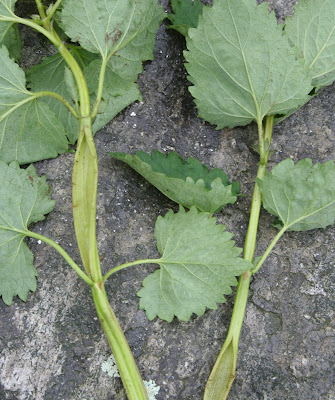Even though we've been at this for a while, we're still very much novices and sometimes it can be next to impossible to tell the difference between perennials we've planted and well.... perennial WEEDS! And while we know most of the common garden pests and have managed to find eco-safe, totally natural ways to control them, we stumbled upon a problem this week that has us stumped.
Please check out the pictures and hopefully a savvy reader will be able to shed some light on this week's garden mysteries.
Do you recognize this plant? We had large clumps of columbine, cranesbill, some penstemon, phlox, and I don't have a clue what else.We thought it was one of the perennials we had planted there until it began overtaking the entire area.
It began the season as a dense clump just like all of the other perennials in that area but now it is becoming quite large shrub that is overtaking many of the other perennials that we do recognize.
I have a sneaky suspicion it's an interloper but if it is something I chose for this bed, I need to either rein it in or perhaps move it. Ideas, anyone?
 |
| Seen here alongside some columbine, it is about 3 feet wide and high, shrubby and woody. It's taking over a section of the full sun perennial bed. |
 |
| Close-up of the leaves and branches |
My next problem is equally perplexing. This plant was labeled as anise hyssop, although it does not really smell like I think it should (at least not to me, anyway). In fact, if it does have a fragrance, it has managed to elude me. I believe it had purple flowers last year but honestly, that could be a figment of my imagination.
However, what concerns me most (aside from confirming that this is truly anise hyssop) is that something has literally slit the stems! Has anyone ever seen anything like this before? It's been raining a lot and I've seen slugs in other areas of the garden but not in this bed. That doesn't mean they aren't here, of course, just that I didn't happen to spot any and I spent a lot of time weeding that bed.
Could a slug have done this? Although it didn't seem to damage the leaves, the stem was literally fileted, and sometimes just segments of it, between leaves.
At the first hint of sunshine, we're going to be spreading diatomaceous earth which should solve the problem if indeed it is the work of slugs, but if not, we need a back-up plan to prevent further damage.





Hi Cathy - Do you think your mystery plant could be a spirea (maybe Spiraea thunbergii)? As far the split stems, this may sound crazy, and I can't give you my rationale for it, but...I wonder if it might be due to excessive rain? That might account for the lack of scent right now too. I could be totally off base, though.
ReplyDeleteI'll be in touch about your e-mail later today or tomorrow. Putting the final touches on my next book today!
Nan,
ReplyDeleteYes, it very well could be a spirea. I think I'll transplant part of it and keep an eye on it. I looked at reference pix, and I don't think it's a tunbergii but I DO think you're right about it being a spirea! Whew!
As for the hyssop, everything you wrote makes total sense, actually. We have had near constant precipitation, from heavy rain to minor drizzle, and the leaves could have been weighted down by water.
I can't wait for your next book!
Thanks for the help!
Cathy